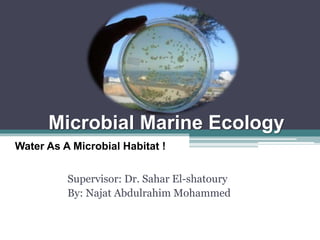Microbial Marine Ecology
This document provides an overview of microbial marine ecology. It discusses the key components of aquatic ecosystems and how microbes play an important role as decomposers and in maintaining balance. Approximately 75% of the Earth's surface is covered by water, with oceans making up the largest portion. The document outlines the different categories of water environments and zones that microbes can inhabit. It also examines the dominant factors that can affect aquatic microbial communities, such as pH, temperature, light penetration, dissolved oxygen, and carbon dioxide levels. In general, this summary gives a high-level introduction to aquatic microbial habitats and the abiotic factors that influence the diversity of microorganisms found in water.

Recommended
Recommended
More Related Content
What's hot
What's hot (20)
Viewers also liked
Viewers also liked (20)
Similar to Microbial Marine Ecology
Similar to Microbial Marine Ecology (20)
Microbial Marine Ecology
- 1. Microbial Marine Ecology Supervisor: Dr. Sahar El-shatoury By: Najat Abdulrahim Mohammed Water As A Microbial Habitat !
- 2. Contents (1): (What-How-why)s 1) What is the? • The ecosystem? • Water content on Earth? • Water categories ? • Water zones ?
- 3. 1. Ecosystem. • The community of organisms in an area and the physical factors with which those organisms interact. Species Habitat Abiotic factors Abiotic factors: Temperature, water salinity, sunlight, soil, precipitation.
- 5. Water content on Earth: • 75% of the earth’s surface is water. • Most biosphere is water ecosystem.
- 6. Water categories: Fresh Water • Standing (lakes and ponds) • Flowing (rivers and streams) Both • Wet lands Areas that are saturated with water either permanently or seasonally Marine Water • Seas • Oceans
- 7. Water Zones:
- 8. Microbes in the Ecosystem: • The main role of microbes : 1. Decomposers. 2. Maintain the balance of the ecosystem. • Understanding the diversity of microorganisms helped the microbiologists to solve some problems as global warming, diseases and pollution.
- 9. Microbial communities: • Microbes are very divers according to the location that is found in • It maybe found in expected areas: rivers, lakes and the oceans.. • Also it’s found in water-saturated zones ( wet lands) in materials we usually describe.
- 10. Dominant Factors That Affect The Aquatic Microbial Environment: • pH: It can range from acidic to extremely alkaline. • Temperature: • Lowest degree: -5 to -15 °C • Highest degree: 121 °C Example: Thermus aquaticus the source of temperature stable DNA polymerase which makes PCR possible.
- 11. Dominant Factors That Affect The Aquatic Microbial Environment: • Penetration of sunlight • Dissolved Oxygen • Mixing nutrients • Waste products • Other gases ( Methane, Nitrogen and Hydrogen).
- 12. 1. Dissolved Oxygen • The solubility of oxygen increases in colder temperature and higher atm. pressure. • In the very deep oceans oxygen concentrations increase with depth.
- 13. 1. Dissolved Oxygen • In tropical lakes and summer time temperate lakes may become oxygen limited only meters below the surface. Aerobic microbes consume all surface oxygen forming anoxic zones. • Anaerobic microbes grow ( phototrophic, heterotrophic) on the lower regions according to light penetration.
- 14. Carbon Dioxide (CO2) • The pH of water is determined by the dissolved CO2 in equilibrium with the air. In the freshwater pH Is controlled by: (weakly buffered) 1. Nature of terrestrial input (minerals) . 2. Rate of CO2 removed by autotrophs .
- 15. Carbon Dioxide (CO2) • In the marine water pH Is controlled by: (strongly buffered) Carbonate ooze
- 16. Carbonate Equilibrium System Calcium carbonate, [Ca][CO3] is a very common mineral. Limestone is one familiar form of calcium carbonate. Acids in acid rain promote the dissolution of calcium carbonate by reacting with the carbonate anion. One that is important in surface waters is the carbonic acid/bicarbonate buffer.
- 17. 3- Other gazes: • Nitrogen used as nitrogen source by nitrogen fixers. • Hydrogen: waste product of vital processes. • Methane. All vary in there water solubility and methane is the least soluble of the three.
- 18. 4- Light penetration :
- 19. Organic Carbon availability: Water Fresh Marine • Organic carbon is fixed by plants and macroalgae • Organic carbon enter the system by terrestrial run off. • In open ocean all organic carbon is product of microbial autotrophy • One half of carbon fixation on Earth is made in oceans
- 20. Photic zone Photic zone Marine Fresh Photic zone maybe only a meter or two in depth In areas where water seems crystal clear Photic zone ranges from 150 – 200 m
- 21. 5- Solar Radiation: • Solar radiation intensity can change the water temperature, so the water starts to form layers of water according to its temperature. • The warm water will floating above the cold water this layers will remain separated until any changes in weather, which will mix the two layers together after cooling the upper layer.
- 22. Thermocline
- 23. Thermocline:
- 24. •Thank you!